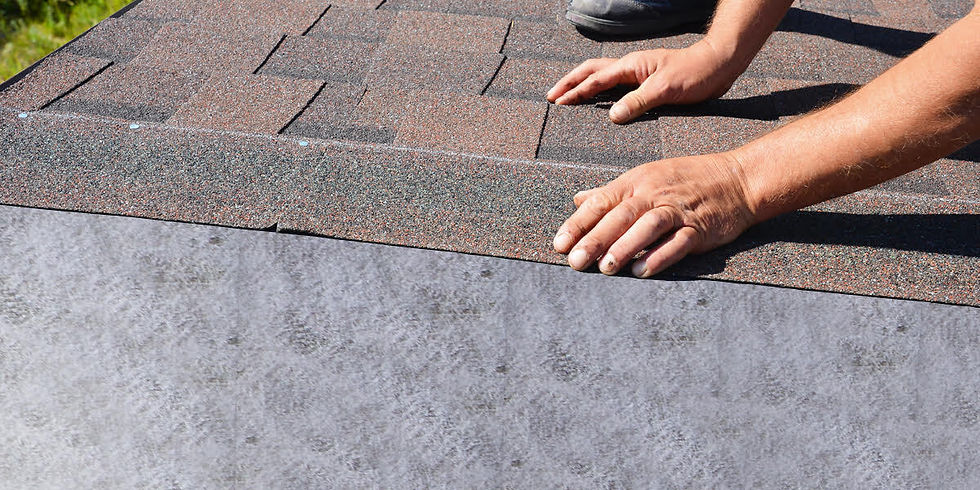What Is Roofing Underlayment and Why Does It Matter?
- Craig Gouker Roofing
- Nov 22, 2024
- 4 min read
When it comes to roof installations and repairs, roofing underlayment may not always be top of mind for homeowners. However, this crucial layer plays a significant role in protecting your home from the elements and ensuring the longevity of your roof. In this blog post, we will explain what roofing underlayment is, why it’s so important, and how it helps safeguard your home.

What is Roofing Underlayment?
Roofing underlayment is a protective layer that sits between the roof deck (the wood or other material that forms the base of your roof) and the roofing materials, such as shingles, metal panels, or tiles. This material is typically made of asphalt-saturated felt, synthetic materials, or rubberized membranes, and it serves as a waterproof barrier.
Underlayment acts as an extra layer of defense against water infiltration, providing an added level of protection in case the top roofing material fails. It is installed directly on the roof deck before shingles or other roofing materials are placed on top.

Why Does Roofing Underlayment Matter?
Enhanced Water Protection: One of the main functions of underlayment is to prevent water from seeping into your home. If water manages to penetrate the roofing materials, underlayment acts as a barrier, directing water away from the roof deck and preventing leaks. This is particularly important in areas with heavy rain or snow, where water runoff can easily reach the vulnerable parts of your roof.

Wind and Storm Resistance: High winds can lift shingles, tiles, or metal roofing panels, exposing your roof deck to water. Roofing underlayment adds an extra layer of protection against wind uplift, preventing the top layers from being torn off during a storm. Some underlayment products are designed with strong adhesive backing that ensures the material stays in place even in extreme weather conditions.

Protection from Ice Dams: Ice dams are a common issue in colder climates, where melting snow on the roof refreezes at the eaves. This creates a blockage that prevents water from properly draining off the roof, which can cause water to back up and leak into your home. Underlayment, especially ice and water shield underlayment, offers added protection at vulnerable areas of the roof, such as the eaves, valleys, and skylights, preventing ice dams from forming.

Improved Insulation: Certain types of roofing underlayment also provide thermal protection, helping to regulate your home’s temperature by improving insulation. This can contribute to energy savings by keeping the home cooler in the summer and warmer in the winter. Some synthetic underlayment products are designed to reflect heat and help maintain a comfortable indoor environment.

Increased Roof Longevity: Underlayment can significantly extend the lifespan of your roof by protecting the deck from moisture, reducing the risk of rot and decay. Over time, exposure to water can cause the roof deck to weaken, leading to costly repairs or even the need for a full roof replacement. Underlayment creates a strong, moisture-resistant barrier that helps preserve the integrity of your roof.

Preventing Mold and Mildew Growth: Mold and mildew thrive in wet environments, and the roof is one of the most vulnerable areas for mold growth. Without proper protection, moisture that seeps into the roofing system can lead to mold, which can cause significant damage to both the structure of your home and your health. By providing a waterproof barrier, underlayment helps prevent mold growth and keeps your home safe and dry.

Types of Roofing Underlayment
Not all underlayment materials are created equal. The three most common types of roofing underlayment are:
Asphalt-Saturated Felt: This traditional underlayment material is made of a fiberglass or polyester base soaked in asphalt. It is durable, affordable, and widely used, though it can be prone to cracking and tearing over time.

Synthetic Underlayment: Made from a combination of polypropylene or polyester, synthetic underlayment is lightweight, durable, and resistant to tears, UV rays, and moisture. It provides superior protection and lasts longer than traditional felt.

Rubberized Asphalt Underlayment: This type of underlayment is often used for areas where water infiltration is a particular concern, such as along the roof’s eaves, valleys, and around chimneys. It features a self-adhesive backing that sticks to the roof deck, providing an extra layer of waterproof protection.

When Should You Replace Your Roofing Underlayment?
Roofing underlayment is designed to last for many years, but it may need to be replaced if your roof is damaged or if you're undergoing a full roof replacement. If you're noticing leaks, signs of water damage, or missing shingles, it’s a good idea to have your underlayment inspected by a roofing professional. Over time, underlayment may deteriorate, particularly in areas exposed to harsh weather conditions, so replacing it during a roof replacement can ensure your home remains well-protected.

Why Choose Craig Gouker Roofing for Your Roof Installation or Repair?
At Craig Gouker Roofing, we understand the importance of high-quality roofing materials, including underlayment. Whether you're installing a new roof or replacing an old one, we use the best products to ensure your home remains protected for years to come. Our expert team can help you choose the right underlayment material based on your roof type, climate, and budget, providing long-lasting protection from the elements.
Schedule Your Roof Inspection Today!
If you're considering a roof replacement or need an inspection, contact Craig Gouker Roofing today. Our experienced team will assess your roofing system, including the underlayment, and provide recommendations for repairs or replacements. Don’t wait for leaks to damage your home—contact us today!





Comments